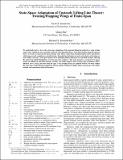| dc.contributor.author | Zhu, Qiang | |
| dc.contributor.author | Izraelevitz, Jacob Samuel | |
| dc.contributor.author | Triantafyllou, Michael S | |
| dc.date.accessioned | 2019-01-22T18:53:08Z | |
| dc.date.available | 2019-01-22T18:53:08Z | |
| dc.date.issued | 2017-01 | |
| dc.identifier.issn | 0001-1452 | |
| dc.identifier.issn | 1533-385X | |
| dc.identifier.uri | http://hdl.handle.net/1721.1/120112 | |
| dc.description.abstract | In this paper, a low-order state-space adaptation of the unsteady lifting line model has been analytically derived for a wing of finite aspect ratio, suitable for use in real-Time control of wake-dependent forces. Each discretization along the span has between 1-6 states to represent the local unsteady wake effects, rather than remembering the entire wake history which unnecessarily complicates controller design. Sinusoidal perturbations to each system degree of freedom are also avoided. Instead, a state-space model is fit to individual indicial functions for each blade element, allowing the downwash and lift distributions over the span to be arbitrary. The wake geometry is assumed to be quasi steady (no roll up) but with fully unsteady vorticity. The model supports time-varying surge (a nonlinear effect), dihedral, heave, sweep, and twist along the span. Cross-coupling terms are explicitly derived. This state-space model is then validated through comparison with an analytic solution for elliptic wings, an unsteady vortex lattice method, and experiments from the literature. | en_US |
| dc.publisher | American Institute of Aeronautics and Astronautics (AIAA) | en_US |
| dc.relation.isversionof | http://dx.doi.org/10.2514/1.J055144 | en_US |
| dc.rights | Creative Commons Attribution-Noncommercial-Share Alike | en_US |
| dc.rights.uri | http://creativecommons.org/licenses/by-nc-sa/4.0/ | en_US |
| dc.source | Other repository | en_US |
| dc.title | State-Space Adaptation of Unsteady Lifting Line Theory: Twisting/Flapping Wings of Finite Span | en_US |
| dc.type | Article | en_US |
| dc.identifier.citation | Izraelevitz, Jacob S. et al. “State-Space Adaptation of Unsteady Lifting Line Theory: Twisting/Flapping Wings of Finite Span.” AIAA Journal 55, 4 (April 2017): 1279–1294 © 2016 The Authors | en_US |
| dc.contributor.department | Massachusetts Institute of Technology. Department of Mechanical Engineering | |
| dc.contributor.mitauthor | Izraelevitz, Jacob Samuel | |
| dc.contributor.mitauthor | Triantafyllou, Michael S | |
| dc.relation.journal | AIAA Journal | en_US |
| dc.eprint.version | Original manuscript | en_US |
| dc.type.uri | http://purl.org/eprint/type/JournalArticle | en_US |
| eprint.status | http://purl.org/eprint/status/NonPeerReviewed | en_US |
| dc.date.updated | 2019-01-08T13:43:24Z | |
| dspace.orderedauthors | Izraelevitz, Jacob S.; Zhu, Qiang; Triantafyllou, Michael S. | en_US |
| dspace.embargo.terms | N | en_US |
| dc.identifier.orcid | https://orcid.org/0000-0002-1555-9136 | |
| dc.identifier.orcid | https://orcid.org/0000-0002-4960-7060 | |
| mit.license | OPEN_ACCESS_POLICY | en_US |
